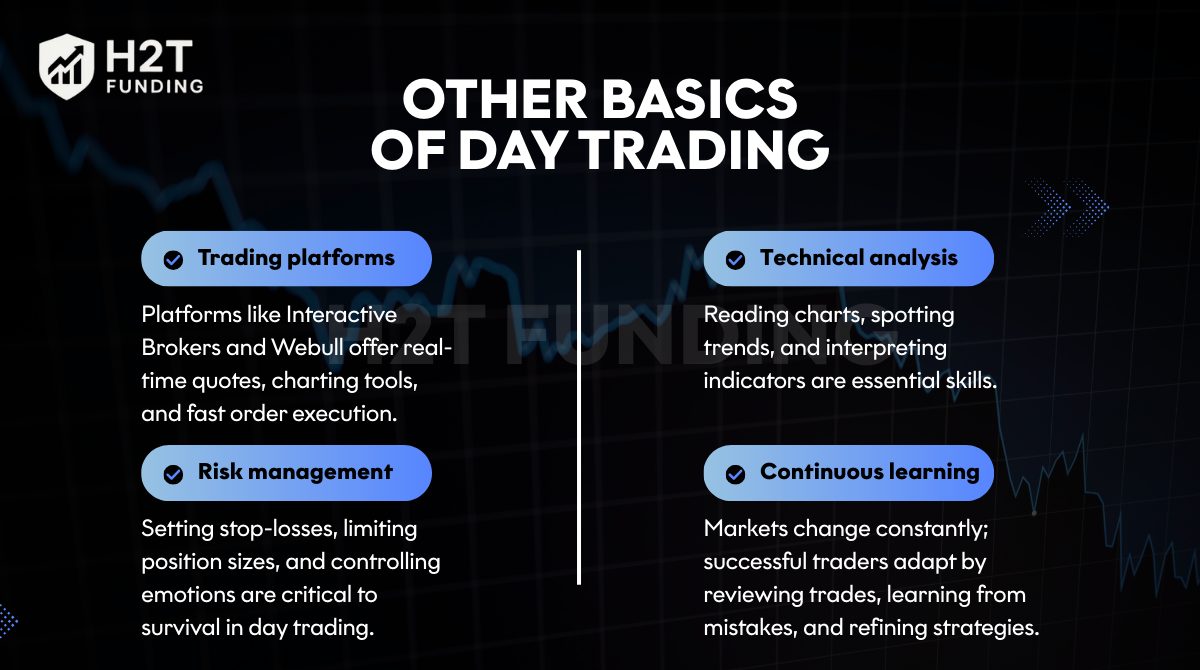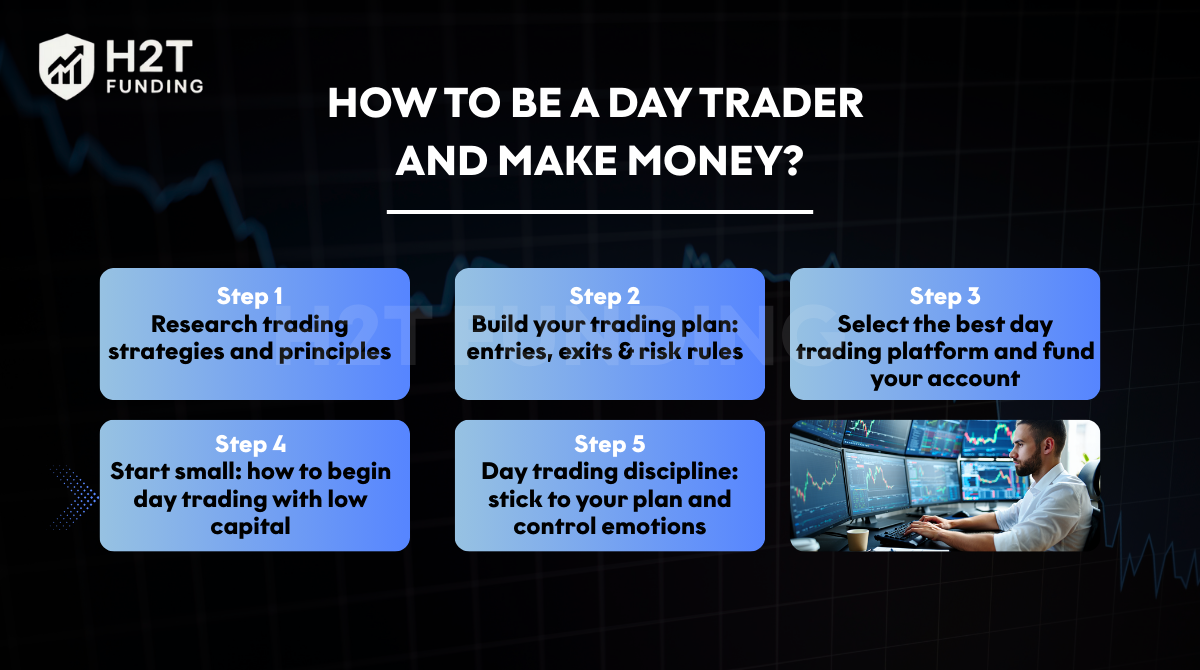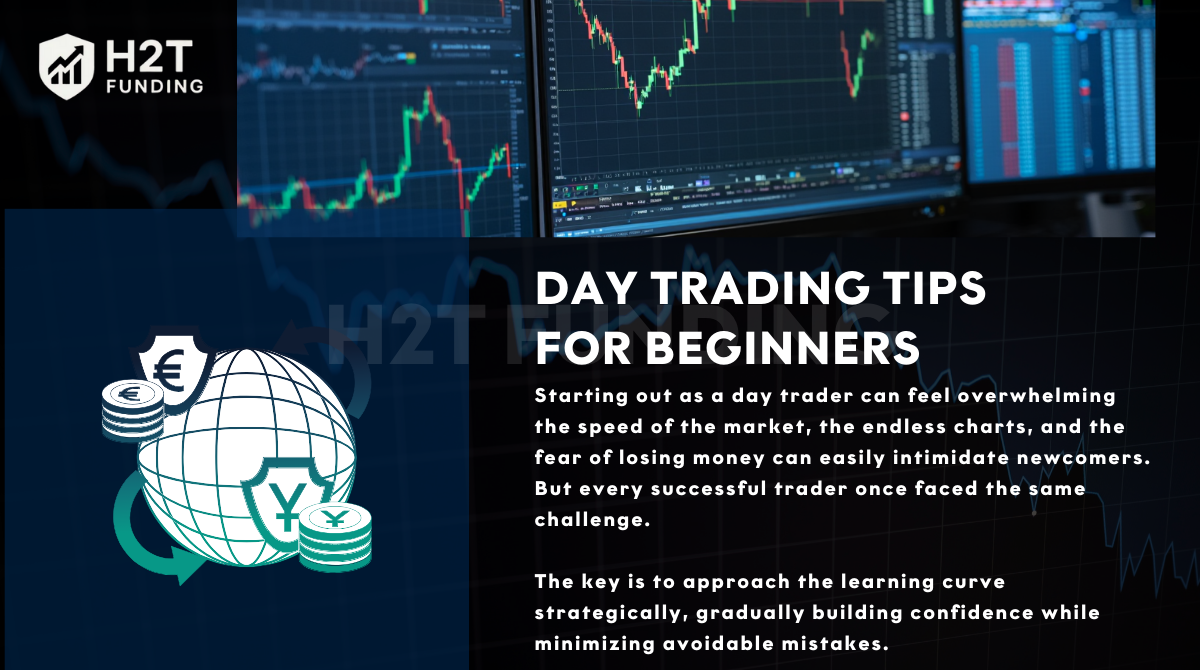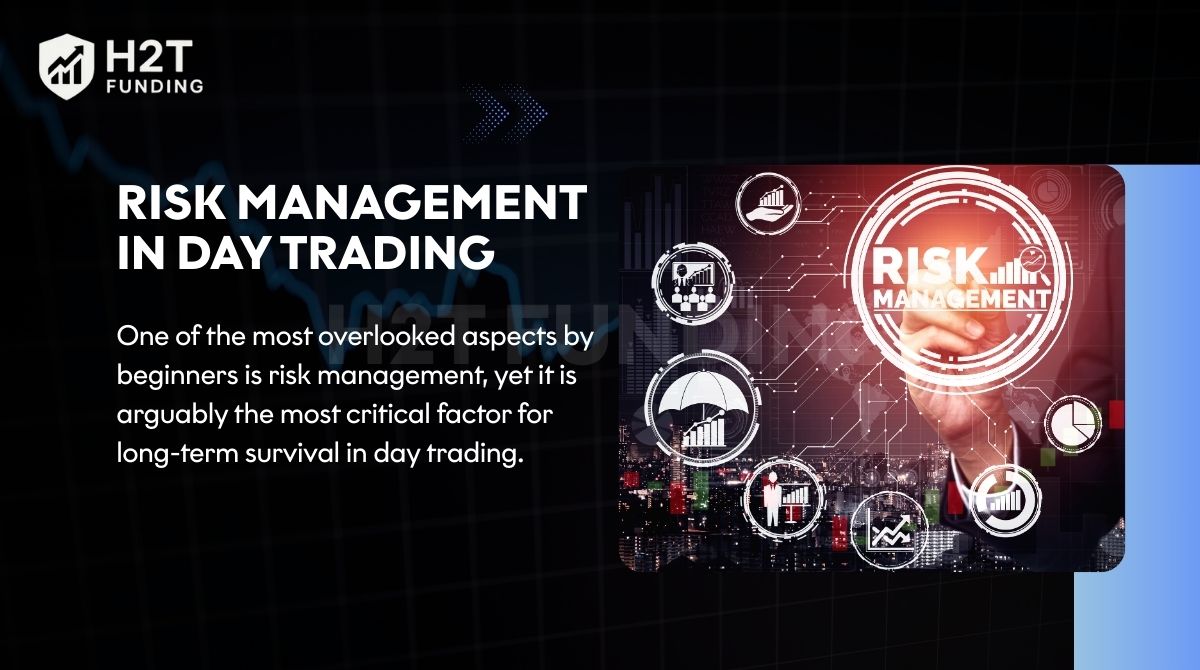How to be a day trader and make money? Guide by H2T Funding
.jpg)
Day trading is often portrayed as a fast-paced world where fortunes can be made in minutes, but the reality is a journey of incredible growth and potential. Many aspiring traders dream of turning a few clicks into a steady income, and with the right mindset, a journey of discipline and unwavering focus, that dream is completely within reach.
Whether you’re drawn to the electric thrill of rapid market movements or the potential to finally take control of your financial future, understanding the foundations is crucial. This guide is your first step on the path, a roadmap to help you grasp the essentials of day trading while exploring practical insights that will set you on the road to success.
This is your chance to discover how to be a day trader and make money, not just as a dream, but as a tangible reality.
1. Basic understanding of day trading
Before diving into the strategies and tips, it’s important to grasp the basics: what day trading really is, how it works, and why it attracts so many people. This foundational knowledge is a necessary first step in your journey, helping you approach the market with proper preparation.
1.1. What is day trading?
Day trading is an exhilarating trading style where financial instruments such as stocks, options, or currencies are bought and sold within the same trading day. The main goal is to profit from small price fluctuations, often leveraging your sharp speed, perfect timing, and mastery of technical analysis.

Day trading is a fast-paced style of buying and selling financial instruments within a single day
Unlike long-term investing, which can feel slow and passive, day traders thrive on action, making multiple trades in a single day, sometimes holding positions for mere minutes or hours.
It’s an approach that demands laser focus, lightning-fast decision-making, and a solid understanding of market behavior. While it can be highly rewarding, it’s a journey that requires careful planning, but for those who are ready, the rewards are absolutely worth the challenge.
1.2. How does day trading work?
At its core, day trading is an exciting hunt for opportunities where short-term price movements unlock incredible profit potential. Traders become masters of their craft, relying on powerful tools like candlestick charts, trendlines, and technical indicators to pinpoint the perfect entry and exit points. The key to this dynamic pursuit lies in:
- Liquidity: Choosing assets you can jump into and out of in a flash, ensuring your moves are always precise.
- Volatility: Focusing on assets with enough energy to create the thrilling price movements you need to capture profits.
- Volume: Trading assets with high daily activity, guaranteeing you can enter and exit the market with ease and efficiency.
A typical day trader feels the pulse of the market from the opening bell to the close, constantly scanning for compelling patterns, breaking news, or technical signals that light up with potential. While the process may sound simple, executing it successfully is a triumph of discipline, relentless practice, and emotional control, the true qualities of a successful trader.
1.3. Why do people choose day trading?
People are drawn to day trading for a variety of reasons:
- Potential for fast profits: Unlike traditional investing, day trading can generate returns within hours.
- Flexibility and independence: Day trading allows individuals to work from anywhere with an internet connection.
- Excitement and challenge: The adrenaline rush of navigating volatile markets appeals to those who enjoy dynamic, fast-paced environments.
- Skill-based growth: Traders learn to analyze markets, manage risk, and develop strategies that improve with experience.
However, it is crucial to understand that these reasons represent the ideal outcome. The reality is that the same volatility that creates profits is also the primary reason most new traders lose money, making disciplined risk management not just a skill, but a prerequisite for survival.
1.4. Day trading rules and regulations
Day trading isn't a free-for-all; instead, a solid framework of regulations exists to empower and protect both traders and the broader market. These rules aren't roadblocks, they are the guardrails that help you stay on the path to success. Key rules include:
- Pattern Day Trader Rule (FINRA): In the U.S., this rule ensures you have the necessary capital to trade responsibly. If you make four or more day trades within five business days in a margin account, you must maintain at least $25,000 in equity.
- Margin requirements: Traders often use the incredible power of leverage to amplify gains, and these regulations ensure you do so with a safety net, dictating minimum margin levels to keep your risk in check.
- Tax obligations: Every savvy trader knows that short-term gains are subject to taxation. Accurate reporting is an essential part of your journey, ensuring you meet your obligations and can celebrate your success without unexpected penalties.
Understanding and embracing these rules is crucial: they are the foundation of a smart, sustainable trading career. Ignoring them can lead to frustrating account restrictions or unexpected setbacks. Instead, see them as a way to build a strong, lasting foundation.
1.5. Other basics of day trading
Beyond rules and definitions, beginners should be familiar with:

Other basics of day trading
- Trading platforms: Platforms like Interactive Brokers and Webull offer real-time quotes, charting tools, and fast order execution.
- Technical analysis: Reading charts, spotting trends, and interpreting indicators are essential skills.
- Risk management: Setting stop-losses, limiting position sizes, and controlling emotions are critical to survival in day trading.
- Continuous learning: Markets change constantly; successful traders adapt by reviewing trades, learning from mistakes, and refining strategies.
By mastering these fundamentals, aspiring traders can approach day trading with a foundation that balances opportunity and risk, setting the stage for the next step: learning how to be a day trader and make money.
2. How to be a day trader and make money?
Day trading can be exhilarating, but it also tests your patience, emotional control, and risk management skills. This section will guide you step by step on how to approach day trading strategically, minimize mistakes, and increase your chances of profitability.

Step by step on how to approach day trading strategically
2.1. Step 1: Research trading strategies and principles
Before you place your first trade, remember that the most important investment is in your own knowledge. You don’t need a finance degree to start, but building a practical understanding of day trading’s core principles is non-negotiable. Many successful traders agree that this foundation is the most critical factor for long-term survival and growth in the market.
Dive into the exciting world of:
- Technical analysis: Learn to read candlestick charts like a pro, spot hidden patterns, and interpret indicators that reveal the market’s true story.
- Trading psychology: Conquer your inner demons by understanding how emotions like fear and greed can try to sabotage your trades.
- Risk management: Master the art of protecting your capital with smart position sizing, setting stop-losses, and confidently limiting losses on any trade.
Many successful traders will tell you that this foundation is what separates those who are left behind from those who consistently and triumphantly grow their accounts. Read books, attend online courses, and immerse yourself in both historical and live market data. Because in this thrilling world, knowledge isn’t just power, it's your ultimate key to survival and success.
2.2. Step 2: Build your trading plan: entries, exits & risk rules
Once you have a solid understanding of trading principles, the next step is to create a detailed plan. A trading plan is your roadmap, helping you make rational decisions instead of emotional ones.
Your plan should cover:
- Entry and exit criteria: Specify exactly when you will enter a trade and under what conditions you’ll exit.
- Risk per trade: Decide in advance how much capital you are willing to risk on a single trade, usually no more than 1–2% of your account.
- Overall strategy: Outline your approach, whether it’s momentum trading, scalping, or trading news events.
Before risking real money, test your plan using a demo account or real-time simulator. This allows you to experience market conditions and refine your approach without financial exposure.
2.3. Step 3: Select the best day trading platform and fund your account
The right platform can make a huge difference in your trading efficiency. Look for brokers that offer:
- Low transaction fees: High costs can eat away at small profits.
- Fast execution: Seconds can determine whether a trade is profitable or not.
- Reliable tools: Real-time quotes, charting capabilities, and order management systems.
Once you’ve chosen your broker, fund your account with money you can afford to lose. Start modestly trading with smaller amounts helps you gain confidence while protecting your capital from large early losses.
2.4. Step 4: Start small: how to begin day trading with low capital
New traders often feel the urge to go “all in,” but starting small is critical. Trading with limited capital reduces the stress of losses and reinforces the importance of managing risk.
Focus on:
- One or two instruments at a time: Keep it simple until you are comfortable with your strategy.
- Fractional shares or micro-lots: Allows trading smaller positions and experimenting safely.
- Regular review: After each session, analyze your trades, identify mistakes, and adjust your strategy.
Day trading is a journey of constant adaptation. The early phase is about learning, not winning big. Every small trade contributes to building experience and discipline.
2.5. Step 5: Day trading discipline: stick to your plan and control emotions
Even the best strategy can fail without emotional control. Many traders sabotage themselves by chasing losses, overtrading, or deviating from their plan when markets turn volatile.
Discipline involves:
- Following your trading plan strictly: Don’t adjust stop-losses or position sizes impulsively.
- Controlling emotions: Fear and greed are your worst enemies; staying objective is key.
- Reviewing performance: Regularly check your trades against your strategy to ensure consistency.
Success in day trading comes not from occasional lucky trades but from consistently following a well-thought-out plan while maintaining composure under pressure.
Following these steps with discipline is what moves you from simply asking "how to be a day trader and make money" to actually building a process that can lead to success. It's a combination of a practical plan, emotional awareness, and strategic thinking.
3. Day trading tips for beginners
Starting out as a day trader can feel overwhelming the speed of the market, the endless charts, and the fear of losing money can easily intimidate newcomers. But every successful trader once faced the same challenge.

Practical tips that can help beginners navigate the complex world of day trading
The key is to approach the learning curve strategically, gradually building confidence while minimizing avoidable mistakes. Here are practical tips that can help beginners navigate the complex world of day trading and start building a foundation for profitability:
Before diving in, remember: these tips are designed to save you time, money, and stress, helping you avoid the common traps that snare many novice traders.
- Start with a demo account: Practice your strategy in a risk-free environment. Observing market behavior without financial exposure is invaluable and builds confidence.
- Focus on a few instruments: Don’t scatter your attention across dozens of stocks or currencies. Specializing allows you to understand patterns, volatility, and behavior of selected instruments.
- Use proper risk management: Always determine the maximum you are willing to lose per trade (usually 1–2% of your account). Protecting your capital is more important than chasing quick gains.
- Set clear entry and exit rules: Define when to enter a trade and when to exit. Avoid impulsive decisions driven by excitement or panic.
- Keep a trading journal: Document every trade, including the reasoning behind it, results, and lessons learned. Reviewing your journal will reveal patterns, mistakes, and areas for improvement.
- Limit trading during news events: High-impact news can create unpredictable volatility. Beginners should avoid major announcements until they are confident in handling sudden market swings.
- Start small and scale gradually: Begin with low capital and modest positions. Success in day trading is cumulative, not explosive. Each small win and loss teaches you valuable lessons.
- Stay disciplined and emotionally aware: Greed, fear, and impatience are the fastest paths to losing money. Stick to your plan, remain calm, and avoid chasing trades.
- Continuously educate yourself: Markets evolve constantly. Successful traders keep learning, attending webinars, reading new strategies, and reviewing market analysis to stay ahead.
By incorporating these tips into your trading routine, you can reduce mistakes, gain confidence, and build a foundation for long-term success. Remember, day trading is as much about mental strength and discipline as it is about strategy.
4. Some strategies that day traders should use
Mastering day trading is about so much more than just knowing the rules; it’s about unlocking the practical techniques that allow you to make brilliant decisions under pressure. While theory can point the way, it’s the consistent application of these powerful strategies that truly separates the winners from those who struggle.

Some strategies that day traders should use
The following are the go-to techniques used by successful day traders to conquer volatile markets and seize every opportunity:
- Following the trend: One of the most reliable and comforting methods is to trade with the momentum of the market. Buy during strong upward trends and short-sell during downward trends, trusting in the powerful principle that trends often continue until a clear reversal.
- Contrarian investing: For the bold and the brave, this strategy seeks out opportunities when market sentiment is at its extreme. By buying during a sharp decline or selling during a rapid rise, you can capture incredible profits as the market corrects itself. It’s high-risk, but for those who master it, the rewards are immense.
- Scalping: This is the ultimate test of precision and focus, where you capitalize on the tiniest price movements, holding positions for mere minutes or even seconds. It demands lightning-fast execution, but in return, it delivers frequent, incremental gains that build your account with every perfect trade.
- Trading the news: News events don't have to be a source of chaos; they can be a thrilling opportunity. Experienced traders learn to anticipate market reactions to earnings reports, economic indicators, or geopolitical events. While beginners should approach this with caution, when executed with skill, it can present some of the most lucrative opportunities you'll ever find.
By applying these techniques consistently, traders learn to navigate volatility with confidence, seize opportunities with conviction, and manage risk like a true professional. Over time, combining a solid strategy with real-world experience and emotional control builds the unwavering confidence and discipline needed for a sustained, profitable career in day trading.
5. Risk management in day trading
One of the most overlooked aspects by beginners is risk management, yet it is arguably the most critical factor for long-term survival in day trading. Here are the key practices used by experienced day traders to manage risk effectively:

One of the most overlooked aspects by beginners is risk management
- Set stop-loss orders: Always define the maximum loss you are willing to tolerate for each trade. A stop-loss automatically exits your position when the price reaches a predetermined level, preventing emotional decisions and catastrophic losses.
- Use position sizing wisely: Determine the amount of capital to risk per trade, typically between 1% and 2% of your total trading account. This helps prevent a single trade from wiping out your portfolio and ensures you can survive a series of losses.
- Set daily loss limits: Decide on a maximum loss per day. If you hit that threshold, step away from trading. This practice prevents emotionally driven decisions and helps you reset mentally for the next session.
- Diversify trades when possible: Avoid putting all your capital into a single stock or asset. Spreading risk across multiple positions reduces exposure and protects you from sudden market shocks.
- Avoid trading on margin without experience: Borrowing funds can amplify profits but also magnifies losses. Beginners should approach margin cautiously and only use it once they fully understand the associated risks.
- Plan entries and exits carefully: Define clear conditions for entering and exiting trades. Having precise rules reduces impulsive decisions and enhances consistency in risk management.
- Reflect and adjust regularly: After each trading session, review your performance. Identify mistakes, adjust strategies, and learn from patterns of losses or wins. Continuous reflection sharpens judgment and builds emotional resilience.
- Keep emotions in check: Fear and greed are traders’ worst enemies. Discipline in sticking to stop-losses, position sizes, and trade plans prevents emotional reactions from destroying your capital.
Implementing these risk management strategies doesn’t just protect your capital, it builds confidence, enhances decision-making, and creates a sustainable foundation for consistent profitability in day trading. Remember: surviving in the market is just as important as making money.
6. H2T Funding – Trusted support for aspiring day traders
Starting a day trading journey can feel overwhelming. Between navigating market volatility, choosing the right broker, and figuring out funding options, beginners often face uncertainty and stress. This is where H2T Funding steps in as a reliable partner, helping traders gain confidence and make informed decisions on their path to success.

H2T Funding – Trusted support for aspiring day traders
Founded in 2025, H2T Funding has quickly earned a reputation as a transparent, trustworthy platform for traders seeking funding from top proprietary trading firms. Unlike other sources that rely on rankings or promotional content, H2T Funding offers detailed, unbiased reviews, prop firm & trading strategies, real-world testimonials from experienced traders, and thorough analyses of capital requirements.
This ensures that traders can focus on developing their strategies rather than worrying about hidden conditions or unreliable information.
Why aspiring day traders choose H2T Funding:
- Clear and detailed funding insights: Traders gain access to accurate information about trading programs, rules, and funding requirements, removing the guesswork from choosing a prop firm.
- Experienced team support: Led by co-founder whose 15+ years of Forex experience brings real-world trading knowledge, the team guides users through complex decisions with practical advice and actionable insights.
- Global reach and community: H2T Funding has supported thousands of traders from over 150 countries, creating a vibrant community where experiences and lessons are shared, helping newcomers feel connected and empowered.
- Focus on long-term growth: Beyond facilitating funding, H2T Funding provides continuous education and industry updates, ensuring traders can adapt to market changes and build sustainable trading careers.
- Proven results: Internal statistics show up to 65% of newly funded traders used H2T Funding’s tools as their primary reference before joining prop firms. Success rates for profit payouts at highly rated firms reach up to 98%, reflecting the platform’s reliability and the quality of its recommended partners.
One of H2T Funding’s greatest strengths lies in its people. Behind the platform is a dedicated team with deep expertise in global financial markets and strong communication skills, ensuring that every piece of content is both accurate and accessible.
Leading the way is Mr. Do Duc Hoang, Co-Founder and CEO, who brings over 15 years of Forex trading experience at top international banks. His strategic vision and refined trading expertise shape the platform’s direction, making H2T Funding a reliable guide for traders worldwide.
Supporting him is a team of seasoned professionals in finance, marketing, and communications:
- Ethan Stroud – Content Director: A financial content strategist with a decade of experience at Click Media (WPP Group), ensuring articles are both insightful and engaging.
- Tea H2T – Head of Content: A financial analyst who closely follows market movements and trading trends, providing in-depth analysis to help traders strengthen their strategies.
- Ngan Pham – Content Creator: An economics graduate and online marketing specialist who translates complex financial concepts into clear and practical knowledge.
- Minh Chau – Content Writer: A researcher and writer with a deep understanding of the financial market, delivering concise, relevant, and trustworthy insights for diverse investors.
This blend of knowledge and communication expertise has positioned H2T Funding as a trusted financial information hub, empowering thousands of traders with the resources they need for sustainable growth.
For anyone wondering how to be a day trader and make money, H2T Funding isn’t just a guide, it's a strategic ally. By connecting traders with the right resources and funding opportunities, it transforms what can be a daunting start into a structured, confident, and actionable journey.
7. FAQs
7.1. Is day trading profitable?
Yes, day trading can be profitable in theory, but it is exceptionally difficult and the odds of success are very low. While the few successful traders rely on strong discipline, a proven strategy, and effective risk management to earn profits, it's crucial to know that numerous studies and brokerage reports indicate that the vast majority, often cited as over 90% of day traders, ultimately lose money.
Therefore, profitability is possible, but not probable, without extensive preparation and deep knowledge.
7.2. Can you really make money from day trading?
Theoretically, you can make money from day trading, but for most people, it is an extremely difficult path that often leads to losses. Statistics show that the majority of beginner traders lose money, with many losing their entire initial investment within the first few months.
To answer the question of "how to be a day trader and make money", it is crucial to understand that success does not come from luck, but from treating it as a serious business: conducting in-depth research, adhering to a strict strategy, and applying unforgiving risk management rules.
7.3. How much can an average day trader make?
There is no fixed income level for an “average” day trader. A very small percentage of highly skilled, well-capitalized traders can earn a significant income. However, when it comes to the "average" trader, data shows they are typically not profitable and tend to lose money over time. Instead of focusing on a potential income figure, a new trader's initial goal should be to achieve break-even and consistent profitability, however small, before thinking about it as a source of income.
7.4. What is the 2% rule in day trade?
The 2% rule is a common risk management guideline. It means that a trader should not risk more than 2% of their total trading capital on a single trade. For example, if you have $10,000 in your account, your maximum loss per trade should not exceed $200. This helps protect accounts from large drawdowns and keeps trading sustainable over time.
7.5. Is $100 a day good for day trading?
Earning $100 per day can be considered a good result for many retail traders, especially those starting with smaller accounts. Over time, consistent $100 daily gains can accumulate into a meaningful monthly income. However, traders should focus on following their strategy and managing risks, rather than chasing a fixed dollar amount each day.
7.6. Why is a transaction controversial?
A trading transaction may become controversial if it involves unclear execution, hidden fees, or conflicts of interest between brokers and clients. In some markets, rapid buying and selling can also raise concerns about market manipulation. This is why choosing a regulated broker and understanding fee structures is essential for safe and fair day trading.
7.7. Can day trading be a full-time career?
Yes, some traders successfully build day trading into a full-time career. However, this path requires years of practice, sufficient capital, and a strong mindset to handle both profits and losses. For most people, day trading begins as a part-time activity until they develop enough skill, consistency, and financial stability to pursue it as a primary source of income.
8. Conclusion
Learning how to be a day trader and make money is a journey that demands patience, discipline, and the right knowledge. It’s not just about chasing quick wins, it's about building the mindset and skills that can turn short-term trades into long-term consistency.
Many beginners underestimate the emotional and financial challenges, but those who take the time to prepare, learn from mistakes, and apply proven strategies are far more likely to succeed.
If you want to explore further and start your funded trading journey effectively, visit H2T Funding to access the latest reviews and tools to select the best prop trading firm for you.
Contact information:
- Website H2T Funding: https://h2tfunding.com/
- Office address: LV 4, 4/567 Group 10 Hoa Lan 1 Residential Area Thuan An, Binh Duong, Việt Nam
- Email us: h2t.funding@gmail.com
- Office hours: Monday-Friday: 9:00 AM - 5:00 PM EST

.jpeg)
.jpg)